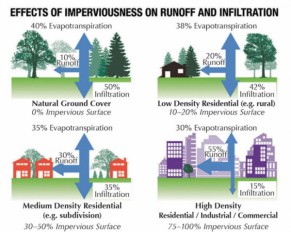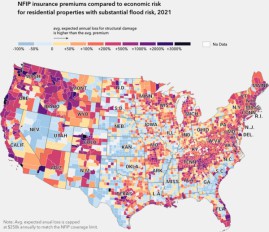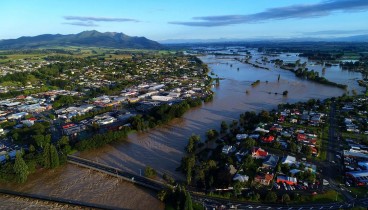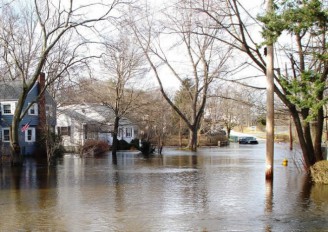New study explains how global warming significantly increases the size of floods

According to new research evidence, warming environment leads to more rainfalls and less snow accumulation, a fact that results in higher flooding.
The new study, recently published in Water Resources Research Journal, suggests that climate change has caused significant temperature rise and a crucial proportion of former snowfalls has been replaced by additional precipitation. The study focuses on data gathered in the western United States.
Scientists from Standford University in California, suggest that the flood area in a region increases in a different way than the amount of precipitation provided. While a consensus view would suggest that as rainfalls increase, flood size would also grow in a similar manner, the study shows that there is a non-linear correlation between the two. In fact, flood size increases exponentially with precipitation accumulation.
Researchers studied the characteristics of 410 watersheds for 36 years beginning in 1980. They focused on measurements of the streamflow conducted on a regular basis by the United States Geological Survey (USGS) and managed to associate the largest rainfall incidents with the highest streamflows observed. The results showed that floods associated with precipitation may be more than 2,5 times larger than those triggered by snowmelt.
The study suggests that, given the current data, people responsible for future infrastructure should be in high alert and consider the ramifications of climate change. “Planners are being asked to project forward what kind of conditions today’s infrastructure will have to withstand in the coming years and decades. Both the shape and magnitude of our non-linear results have the potential to benefit planners in Western states that are trying to integrate the changing nature of snow hydrology into their decisions,” Dr. Noah Diffenbaugh, co-author of the study and the Kara J Foundation Professor and Kimmelman Family Senior Fellow at Stanford University, stated.
Scientists managed to combine econometrics, a discipline based on the application of statistical models to existing data in order to create empirical correlations, with hydrology. To take into consideration other parameters associated with flood size, they investigated the impact of the soil properties, the inclination and the usage of the ground.
The study warns that authorities in regions that have already been or will be affected by global warming should consider the long-term hazard of floods as the amount of precipitation changes. Researchers present the Oroville Dam failure (in 2017), which resulted in the evacuation of 180,000 people as an example of the threat that floods pose to the existing infrastructure. “The Oroville Dam crisis is a good example of how existing infrastructure is already vulnerable to flooding. These results show that warming alone – even without changes in precipitation amounts – could lead to changes in the size of floods,” Frances Davenport, lead author of the study and a Ph.D. candidate in Earth system science at Stanford’s School of Earth, Energy & Environmental Sciences, stated.
Source: Stanford
Source: Stanford
Want to read more like this story?

Evaluating the impact of urban development on flood risk
Feb, 13, 2020 | NewsAccording to a new study, urban development may cause severe issues when it comes to flooding risk....

New satellite mission will enable better flood prediction modeling
Sep, 30, 2019 | NewsAccording to a recent study, a new satellite, set to launch in 2021, will offer a better understandi...

Elevating houses to address flood risks: A detailed analysis
Oct, 26, 2020 | NewsElevating structures is a method that is widely utilized (especially in the United States) to tackle...

Flood risk increase for US infrastructure due to climate change: Insurance rates tend to underestimate the current conditions
Mar, 01, 2021 | NewsThe risk of flooding can cause severe damage to infrastructure. New evidence revealed that the poten...

Hydrologic Cycle in the Balance for Midwest US
May, 20, 2015 | NewsA new study from Dartmouth College suggests that the fate of the climate during the summer growing s...

Climate change brings new challenges in road surfaces
Jul, 24, 2019 | NewsAccording to a new study, the thickness of asphalt layers should increase by 7% to 32% in order...

How climate change has affected real estate business
Nov, 11, 2019 | NewsClimate change is a phenomenon that leads to sea water-level rise affecting the coastal areas. But h...

New Zealand massive floods: Thousands evacuated
Feb, 07, 2020 | NewsNumerous people have been evacuated after extreme rainfalls resulted in massive floods in New Zeala...

New parameter in flood risk assessment recent study reveals
Jan, 28, 2015 | NewsWith half a million dollars spent to adress direct flooding costs in the U.S. in 2012, flood risk ev...
Trending

Vertical gardens in Mexico City to combat pollution

Saudi Park Closed After 360 Big Pendulum Ride Crashes to Ground, 23 injured

Characteristics of Load Bearing Masonry Construction

Taipei 101’s impressive tuned mass damper

Dutch greenhouses have revolutionized modern farming

Federal court rules Biden’s offshore drilling ban unlawful


